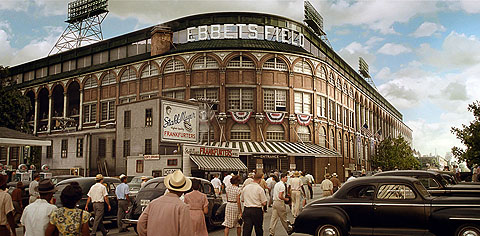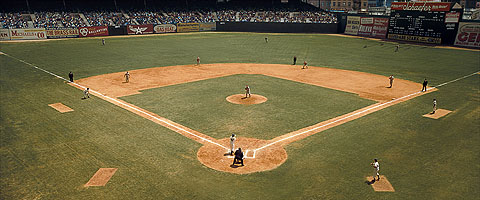Minors parks in marquee in biopic '42'
The story of Jackie Robinson is hardly one that has been mired in obscurity, as in the 40 years since his death he's been the subject of dozens of books, awarded the Presidential Medal of Freedom, and, most significantly, had his No. 42 retired by the entirety of professional baseball.
That uniform number, perhaps the most iconic in American sports history, has been further immortalized thanks to 42, the Robinson biopic that opens Friday in theaters nationwide. The movie, which begins with Jackie as a member of the 1945 Kansas City Monarchs and then follows him through the conclusion of his epochal 1947 Brooklyn Dodgers campaign, is the most ambitious cinematic telling of Jackie's barrier-busting tale yet attempted.
Brian Helgeland, 42's writer and director, was wise to restrict the action to this pivotal two-year period of Robinson's life. But even though the limited chronological scope gives the film time to focus on the specifics of the 1947 season, Robinson (portrayed with quiet intensity by Chadwick Boseman) comes across more as a stoic embodiment of perpetually thwarted societal ideals than as a nuanced, conflicted, and, yes, flawed flesh and blood human being. That he might be depicted in such a quasi-mythological fashion is made evident early in the film.
• More on 42 from Benjamin Hill: Engels' makeover | Nitkowski's cameo
Dodgers general manager Branch Rickey (played entertainingly, if on the verge of caricature, by a gravelly-voiced, cigar-chomping Harrison Ford) conveys his intent to sign a black player by dramatically declaring, "I don't know who he is, or where he is, but he's out there."
At this point, we are shown Jackie, the (soon-to-be) chosen one, as a member of the barnstorming Negro League Monarchs. His headstrong nature and commitment to equality is quickly established through a quietly contentious interaction with a racist gas station owner, and that scene ends with the convenient arrival of scout Clyde Sukeforth. Might Jackie be interested in playing for the Dodgers?
Thus begins Jackie's Rickey-curated journey, as he and his support team of wife Rachel and writer Wendell Smith head to 1946 Spring Training at Daytona Beach's City Island Ballpark. This marked the first instance in which Jackie would play in an integrated setting, and the ballpark, now home of the Florida State League's Daytona Cubs, has since been renamed in his honor. All but the Newark opener of Jackie's 1946 International League campaign with the Montreal Royals is skipped over -- understandable within the context of 42, but it was a season worthy of a movie in its own right -- and the final two thirds of the film takes us through the tumult and triumph of Brooklyn's pennant-winning 1947 season.

Though our foreknowledge of Jackie's eventual success saps 42 of some of its suspense, there is still much to enjoy along the way. The casting is superb, with supporting actors such as John McGinley (Scrubs' Dr. Perry Cox, as Dodgers announcer Red Barber) and Alan Tudyk (Firefly's Wash as gleefully racist Phillies manager Ben Chapman) enlivening the screen with assured and slyly comic performances. And the baseball scenes themselves do an exemplary job of capturing the energy and speed of the sport as it is played at its highest level; rarely, if ever, have headhunting fastballs and takeout slides felt so visceral and immediate. The possibility of grave physical harm was as much a threat to Robinson as any hyperbolic racist vitriol, and Helgeland does an excellent job of conveying this.
If the on-field action feels like a convincing evocation of baseball as it was played in 1947, then a big reason for that is because 42 was shot at ballparks that were operational during that time period. Chattanooga's Engel Stadium, the former home of the Southern League's Lookouts and now in the process of being restored, served as the stand-in for Brooklyn's Ebbets Field, with the film crew enveloping the facility with a massive 1,200-foot by 40-foot green screen so that visual effects artists could later superimpose a second deck as well as the old Brooklyn skyline.

Similar methods were employed at Rickwood Field, former home of the Birmingham Black Barons, where Jackie once competed as a member of the Monarchs. Recognized as the oldest ballpark in America, Rickwood stands in for visiting ballparks such as Pittsburgh's Forbes Field.
• More on 42 from Benjamin Hill: Engels' makeover | Nitkowski's cameo
Though 42 too often veers toward hagiography, it nonetheless is a movie that needed to be made. Robinson's story has been told and retold for more than six decades -- 1950's The Jackie Robinson Story starred Robinson himself -- but the generally well-acted and always visually vibrant 42 will almost surely reach a far wider audience than any account that has come before. As such, it further enmeshes Robinson within the upper echelon of true American heroes (sporting and otherwise) and helps to ensure that future generations will remain acquainted with and appreciative of athletic accomplishments that resonated far beyond the field of play. Let's just hope that the film serves as a jumping-off point for those interested in Robinson, as opposed to the final word.
Benjamin Hill is a reporter for MLB.com and writes Ben's Biz Blog.